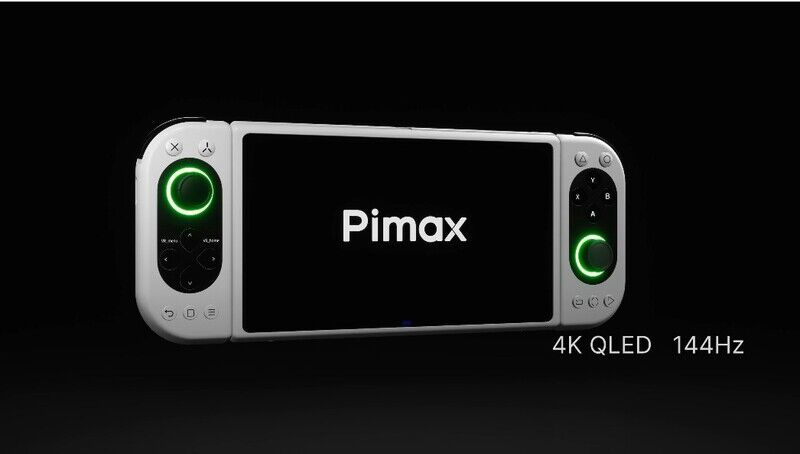
The Pimax Portal QLED Plays Everything on Android and VR
Colin Smith — September 7, 2023 — Tech
References: pimax
'Pimax,' a Shanghai, China-based consumer electronics manufacturer and gaming hardware company, recently completed the launch of its 'Pimax Portal.' This device has been in the works for many years as an Android-powered gaming handheld with detachable controllers and a special Virtual Reality mode.
The Pimax has a premium build quality with a sturdy, no-flex frame, ventilation ports on the rear and top of the device, and detachable bumper controllers that use a high-strength magnetic connection, ensuring that the controllers will never come loose during gameplay. The company does offer a cautionary message when powering the device, though, as the magnetic force used to secure the controllers is quite powerful and can pinch skin if the user is not careful while attaching or detaching controllers. Each of the three models features the same core design, though only the high-end QLED model is equipped with the HDMI-out port, and the lowest-end base model does not feature the roster of cameras for VR usage.
In terms of internal specifications, each model in the Pimax Portal range has the same internal specifications, meaning each device is powered by the powerful Qualcomm Snapdragon XR2, as well as 8GB of RAM. In terms of storage, though, the base model comes with 128GB of storage, while the two higher models feature 256GB of storage. The main different between the models, though, comes from the screen quality.
The devices feature 4K resolution displays. However, the two base models have LCD screens, while the high-end Portal QLED model comes with a QLED + Mini LED display. Aside from this, the only remaining difference is that the high-end model features full VR functionality, as well as HDMI-out and WiGig compatibility, while the two base models do not have all of these features.
In terms of gaming performance, the Portal QLED is one of the strongest Android-powered devices on the market due to its Snapdragon XR2 processor. This makes the Portal competitive with other high-end gaming handhelds, such as the Razer Edge and the AYN Odin, which are powered by the G3X Gen 1 and Snapdragon 845, respectively. The Portal, in fact, has the same internal processor as the Meta Quest 2, meaning it is more than capable of full VR gaming as well.
In synthetic performance testing, the Portal QLED shows its power. In testing through 3D Mark on Wild Life, the Portal achieves a score of 5,300, placing it slightly under the more-expensive Razer Edge, but significantly above prominent competitors such as the Retroid Pocket 3+, AYN Odin, or GPD XP+. In Antutu, the device reaches over 750,000, which is more than enough to power nearly anything on the Android 10 platform.
When it comes to actual real-life gaming and emulation testing, the Portal shines on nearly every emulator and application tested. Up to the 16-bit and 32-bit era, so from retro arcade games from the 80s all the way up to the PlayStation 1 and Nintendo 64, the device can play games at full speed with no frame drops, and on 6x resolution, taking full advantage of the 4K display. On testing more modern systems, the device can play most PlayStation 2 and Nintendo Gamecube or Wii-era games on 3x or 4x resolution at full speed. Lastly, for modern Nintendo games, the device is capable of playing most titles compatible with the emulators at playable speeds, though tweaking is often involved in this process.
For native Android gaming, the Portal QLED handles even the most demanding titles, such as Genshin Impact, Call of Duty Mobile, and Playerunkowns Battlegrounds, with ease. The built-in cooling fan allows the Portal to run games on high-resolution at full-speed without overheating or thermal throttling, except for in the most extreme of cases when the fan is set to "silent" mode in the settings. The device does run into a few quirks when it comes to video streaming, such as being unable to run the Netflix Android application. However, this is not significant as the device is fully compatible with Disney+, Amazon Prime, Youtube, Hulu, and Kodi, enabling users to access the same library of video content regardless.
The Virtual Reality mode for the Portal QLED is not yet fully market-ready, as the Pimax Crystal, the company's companion headset for the device, is not yet publicly available. However, based on the fact that the Portal features the same internal specifications as the Meta Quest 2, it should handle virtual reality titles with ease.
The three versions of the Pimax Portal, as well as the upcoming Portal Retro, can be purchased online from Pimax's official store with prices starting at $368 for the base model, and reaching upwards of $549 for the high-spec QLED model. The versatility of the Portal, particularly with the full range of functionality achieved by the QLED model, make it an excellent purchase for retro gaming, mobile gaming, and high-end emulation as a hybrid handheld-docked console.
Image Credit: Pimax
The Pimax has a premium build quality with a sturdy, no-flex frame, ventilation ports on the rear and top of the device, and detachable bumper controllers that use a high-strength magnetic connection, ensuring that the controllers will never come loose during gameplay. The company does offer a cautionary message when powering the device, though, as the magnetic force used to secure the controllers is quite powerful and can pinch skin if the user is not careful while attaching or detaching controllers. Each of the three models features the same core design, though only the high-end QLED model is equipped with the HDMI-out port, and the lowest-end base model does not feature the roster of cameras for VR usage.
In terms of internal specifications, each model in the Pimax Portal range has the same internal specifications, meaning each device is powered by the powerful Qualcomm Snapdragon XR2, as well as 8GB of RAM. In terms of storage, though, the base model comes with 128GB of storage, while the two higher models feature 256GB of storage. The main different between the models, though, comes from the screen quality.
The devices feature 4K resolution displays. However, the two base models have LCD screens, while the high-end Portal QLED model comes with a QLED + Mini LED display. Aside from this, the only remaining difference is that the high-end model features full VR functionality, as well as HDMI-out and WiGig compatibility, while the two base models do not have all of these features.
In terms of gaming performance, the Portal QLED is one of the strongest Android-powered devices on the market due to its Snapdragon XR2 processor. This makes the Portal competitive with other high-end gaming handhelds, such as the Razer Edge and the AYN Odin, which are powered by the G3X Gen 1 and Snapdragon 845, respectively. The Portal, in fact, has the same internal processor as the Meta Quest 2, meaning it is more than capable of full VR gaming as well.
In synthetic performance testing, the Portal QLED shows its power. In testing through 3D Mark on Wild Life, the Portal achieves a score of 5,300, placing it slightly under the more-expensive Razer Edge, but significantly above prominent competitors such as the Retroid Pocket 3+, AYN Odin, or GPD XP+. In Antutu, the device reaches over 750,000, which is more than enough to power nearly anything on the Android 10 platform.
When it comes to actual real-life gaming and emulation testing, the Portal shines on nearly every emulator and application tested. Up to the 16-bit and 32-bit era, so from retro arcade games from the 80s all the way up to the PlayStation 1 and Nintendo 64, the device can play games at full speed with no frame drops, and on 6x resolution, taking full advantage of the 4K display. On testing more modern systems, the device can play most PlayStation 2 and Nintendo Gamecube or Wii-era games on 3x or 4x resolution at full speed. Lastly, for modern Nintendo games, the device is capable of playing most titles compatible with the emulators at playable speeds, though tweaking is often involved in this process.
For native Android gaming, the Portal QLED handles even the most demanding titles, such as Genshin Impact, Call of Duty Mobile, and Playerunkowns Battlegrounds, with ease. The built-in cooling fan allows the Portal to run games on high-resolution at full-speed without overheating or thermal throttling, except for in the most extreme of cases when the fan is set to "silent" mode in the settings. The device does run into a few quirks when it comes to video streaming, such as being unable to run the Netflix Android application. However, this is not significant as the device is fully compatible with Disney+, Amazon Prime, Youtube, Hulu, and Kodi, enabling users to access the same library of video content regardless.
The Virtual Reality mode for the Portal QLED is not yet fully market-ready, as the Pimax Crystal, the company's companion headset for the device, is not yet publicly available. However, based on the fact that the Portal features the same internal specifications as the Meta Quest 2, it should handle virtual reality titles with ease.
The three versions of the Pimax Portal, as well as the upcoming Portal Retro, can be purchased online from Pimax's official store with prices starting at $368 for the base model, and reaching upwards of $549 for the high-spec QLED model. The versatility of the Portal, particularly with the full range of functionality achieved by the QLED model, make it an excellent purchase for retro gaming, mobile gaming, and high-end emulation as a hybrid handheld-docked console.
Image Credit: Pimax
Trend Themes
1. Android-powered Gaming Handhelds - The Pimax Portal QLED is an Android-powered gaming handheld with detachable controllers and VR mode.
2. High-quality Detachable Controllers - The Pimax Portal features detachable controllers that use a high-strength magnetic connection for secure gameplay.
3. Powerful Snapdragon XR2 Processor - The Pimax Portal is equipped with a powerful Qualcomm Snapdragon XR2 processor for enhanced gaming performance.
Industry Implications
1. Consumer Electronics - Pimax is a Shanghai-based consumer electronics manufacturer that offers the Pimax Portal gaming handheld.
2. Gaming Hardware - Pimax is a gaming hardware company that focuses on creating innovative gaming handhelds.
3. Virtual Reality - The Pimax Portal QLED model features full VR functionality, positioning it within the virtual reality industry.
5
Score
Popularity
Activity
Freshness
























